キーワード: 天文学、宇宙物理、逆問題、スペクトル、テラヘルツ波

インタビュイー:中井 直正 教授(前代表)
南極といえばブリザードと呼ばれる激しい吹雪を連想される方もいて、望遠鏡の設置計画に驚かれるかもしれません。しかし南極大陸の内陸部、標高3000mを超える高原地帯は晴天率が高く風も弱い安定した気候であり、さらには地上で唯一、テラヘルツ波による天体観測が可能な場所なのです(図1)。現在、計画されている南極10mテラヘルツ望遠鏡が目指すのは、生まれて間もない銀河を探し出す遠方銀河の大規模広域サーベイ観測です。銀河がいつどのように生まれたのか、南極からの宇宙観測により現代天文学の重要課題解明に挑戦するリサーチユニットです。
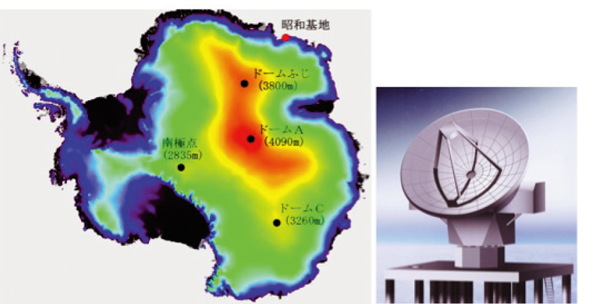
図1:昭和基地から約1000 キロメートルの内陸部には標高3000 メートルを超える高原地帯が広がっている。右は南極10 mテラヘルツ望遠鏡の完成予想図。
遠方銀河の探索から銀河誕生の謎にせまる
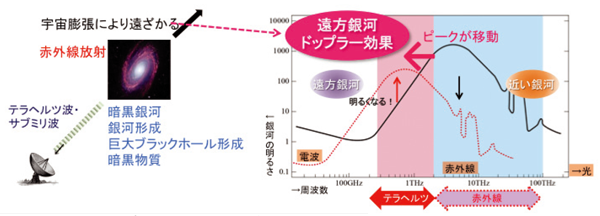
図2:ドップラー効果のため、遠方銀河はテラヘルツ波で明るく観測される。
銀河の光が地上に届くまでには時間がかかるため、遠方にある銀河を観測すると、過去の銀河の姿を観測していることになります。そこで誕生間もない銀河を見つけ出そうと、遠方銀河の探査観測が行われており、代表的なものとしてハッブル宇宙望遠鏡による成果や、すばる望遠鏡による最遠方銀河の発見が知られています。これらの可視光望遠鏡により多くの遠方銀河が発見されていますが、その数はまだ理論的予測の1 ~ 3割程度にしかならず、宇宙には可視光では観測できない「暗黒銀河」と呼ばれる銀河が多数存在すると考えられています。銀河は一般に赤外線で最も明るいのですが、遠方の銀河は宇宙膨張に乗って高速で私たちから遠ざかっているため、ドップラー効果により地上では波長の長いテラヘルツ波(やサブミリ波)で明るく観測されると考えられます(図2)。可視光で観測できない暗黒銀河をテラヘルツ波(~サブミリ波)で探査し、生まれて間もない宇宙初期の銀河を見つけ出すことは、銀河がいつ、どのように生まれたのか、その謎を解明する大きな手がかりになるはずです。このように遠方銀河の観測に非常に有望なテラヘルツ波ですが、大気中の酸素や水蒸気に吸収されやすいため、地上からの観測が困難であり、これまで観測されていませんでした。
地上で唯一、南極に開くテラヘルツ波観測の窓
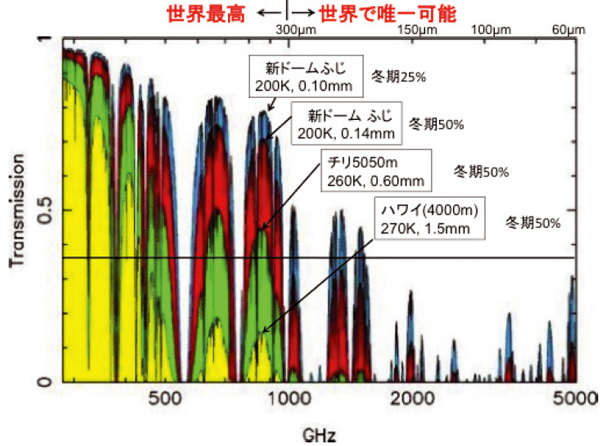
図3:南極(新ドームふじ)とチリ、ハワイにおける大気透過率の計算値。テラヘルツ波(1000 GHz以上)で大気に吸収されず地上に届くのは南極のみ。
大気中の水蒸気による影響を減らすため、標高が高くかつ乾燥している場所が望遠鏡の設置には適しています。アルマ望遠鏡があるチリのアタカマ高原も非常に条件の良い場所ですが、大気中の水蒸気による吸収のためにテラヘルツ波は地上に届きません。それに対して南極内陸の高原地帯は年間平均気温が-54℃、最低気温が-80℃と極寒の地であることから、大気中の水蒸気が極めて少なく、地上で唯一宇宙からのテラヘルツ波が地上に届きます(図3)。
もちろん、南極ならではの課題もあります。最低気温-80℃、最高気温-20℃の温度変化に対し、口径10mアンテナ主鏡面の熱膨張による変形を20μm以下に抑えなくてはなりません。またアンテナ主鏡に霜がつかないよう、主鏡を周囲の大気温度に対し+2 ~ 5度程度に暖める必要があります。加えて望遠鏡の建設地が沿岸部から約1000km以上内陸となるため、建設資材、発電用の燃油など大量の物資輸送をどのように行うのか検討を進めています。これらの課題を解決した先に設置される南極10mテラヘルツ望遠鏡は、新たな宇宙観測の目となります。これまで観測されてこなかったテラヘルツ波が私たちにどのような銀河の姿を見せてくれるのか、大きな期待が寄せられています。
社会への貢献・実績
- 現代天文学の重要課題の解明へ期待
Clarification of Galaxy Formation and Evolution Challenges on the Extremely Cold Antarctic Continent
Unit members : Yoshikawa, Kohji Kim, Shinhong(nobuhiro) Mori, Masao 瀬田 益道 Aoshima, Makoto
Unit name: Promotion of Astrophysics from Antarctica
Key words: astronomy, astrophysics, inverse problem, spectrum, terahertz wave

interviewee; Nakai, Naomasa
When hearing the term “Antarctica,” someone may immediately imagine a furious snowstorm called a “blizzard.” For such people, it may be astonishing that there is a plan to install a telescope on the Antarctic Continent. However, at the highlands, located far from the coast of the Antarctic Continent and exceeding 3000 m in altitude, the climate is relatively modest and stable, characterized by a high percentage of fine days and weak wind. This is the only place available on the globe allowing astronomical observation with the use of terahertz waves (Fig. 1). The 10 m terahertz telescope, now planned to be installed on the Antarctic Continent, is aimed at conducting large-scale and extensive surveys of distant galaxies to find galaxies immediately after birth. This research unit is attempting to clarify the important questions of modern astronomy about when and how galaxies were born, by means of astronomical observation from the Antarctic Continent.

Fig. 1: A highland with altitude exceeding 3000 m is located about 1000 km inside from the Showa Camp of the Antarctic Continent. Right: Concept drawing of the Antarctic 10 m Terahertz Telescope
Approaching the mystery of galaxy birth through exploration of distant galaxies
Because so much time is taken for the light from galaxies to reach the earth, observations of distant galaxies on the earth means observations of the past state of galaxies. Exploration and observations of distant galaxies have thus been carried out to detect galaxies soon after birth. Representatives of such efforts include the outcome of the Hubble space telescope observations and discovery of the most distant galaxy with the Subaru telescope. Although many distant galaxies have been found with such optical telescopes, the number of galaxies found to date is only about 10-30% of the theoretically estimated number, and it is considered that there are many galaxies called “dark galaxies” which cannot be observed at optical wavelengths. Galaxies are generally brightest when observed at infrared wavelengths. However, since distant galaxies are going away from us at a high speed within the expanding cosmos. such galaxies are anticipated to be visible brighter on the globe when observed with long wavelength terahertz waves (or submillimeter waves) due to the Doppler-like effect (Fig. 2). If dark galaxies, that are not possible to observe at optical wavelengths, are explored with the use of terahertz waves (or submillimeter waves) to find galaxies soon after birth, representing the early phase of universe, it will provide a significant clue in resolving the mystery (when and how galaxies were born). Although terahertz waves are very promising as a tool for observations of distant galaxies, observations on the earth using these waves are difficult because terahertz waves are likely to be absorbed by oxygen and moisture in the atmosphere air. Such observations have not been conducted on the earth to date.
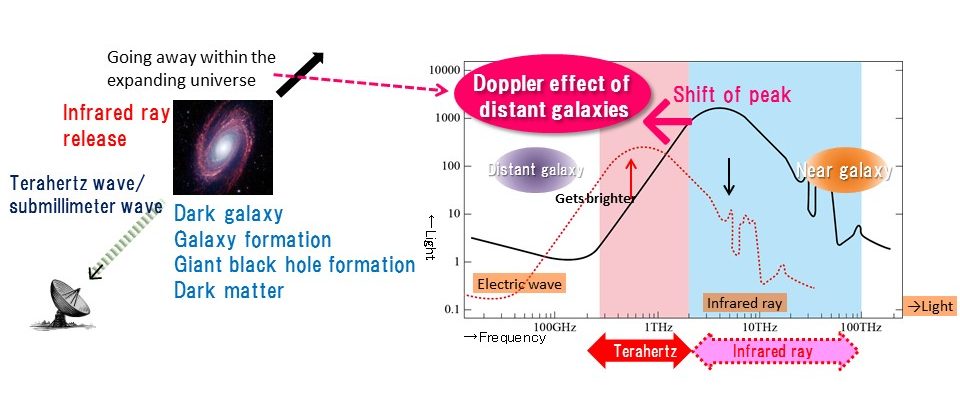
Fig. 2: Distant galaxies are brighter when observed with terahertz waves because of the Doppler-like effect.
The window for terahertz wave observations is open only on the Antarctic Continent
To reduce the influence from water air vapor in the atmosphere, dry places with high altitude are suitable for the installment of telescopes. The Atacama Highlands of Chile, where the ALMA telescope has been installed, is a place with favorable conditions for this purpose, but even here the terahertz waves do not reach the ground because of absorption by water vapor. The highlands inside the Antarctic Continent, on the other hand, is an extremely cold place with an annual average temperature of -54°C and lowest temperature of -80°C. These highlands, quite poor in water vapor, is the only place on the globe where the terahertz waves from the universe can reach the ground (Fig. 3).
Of course, there are problems unique to the Antarctic Continent. It is necessary to suppress the magnitude of thermal expansion-caused deformation of the main mirror surface of the 10 m antenna to 20 μm or less when exposed to a temperature change between -80°C and -20°C. It is also needed to warm the main mirror by +2-5°C relative to the ambient temperature to avoid frost formation on the antenna’s main mirror. Furthermore, because the planned telescope installation site is more than about 1000 km away from the coast, how to transport the large amounts of materials (e.g., construction materials, oil for power generation and so on) to the site is an open issue. The Antarctic 10 m Terahertz Telescope, which will be installed after settlement of these open issues, will serve as a new eye for observation of the universe. Much is expected of the views of galaxies provided by terahertz wave observation not yet performed before.
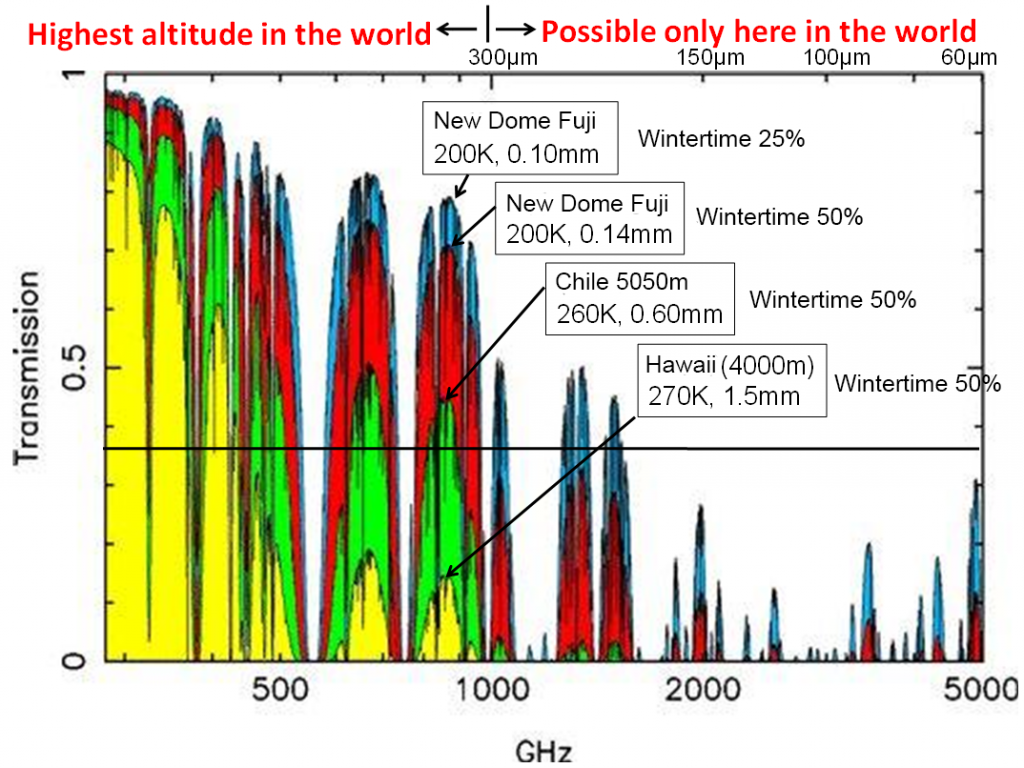
Fig. 3: Atmospheric transmissivity calculated at Antarctica (New Dome Fuji station), Chile and Hawaii. Terahertz waves (1000 GHz or more) can reach the ground without absorption by ambient air only on Antarctica.
Social contributions and achievements
- Expectation of resolving important open issues of modern astronomy
Interviewed on March 17, 2015
